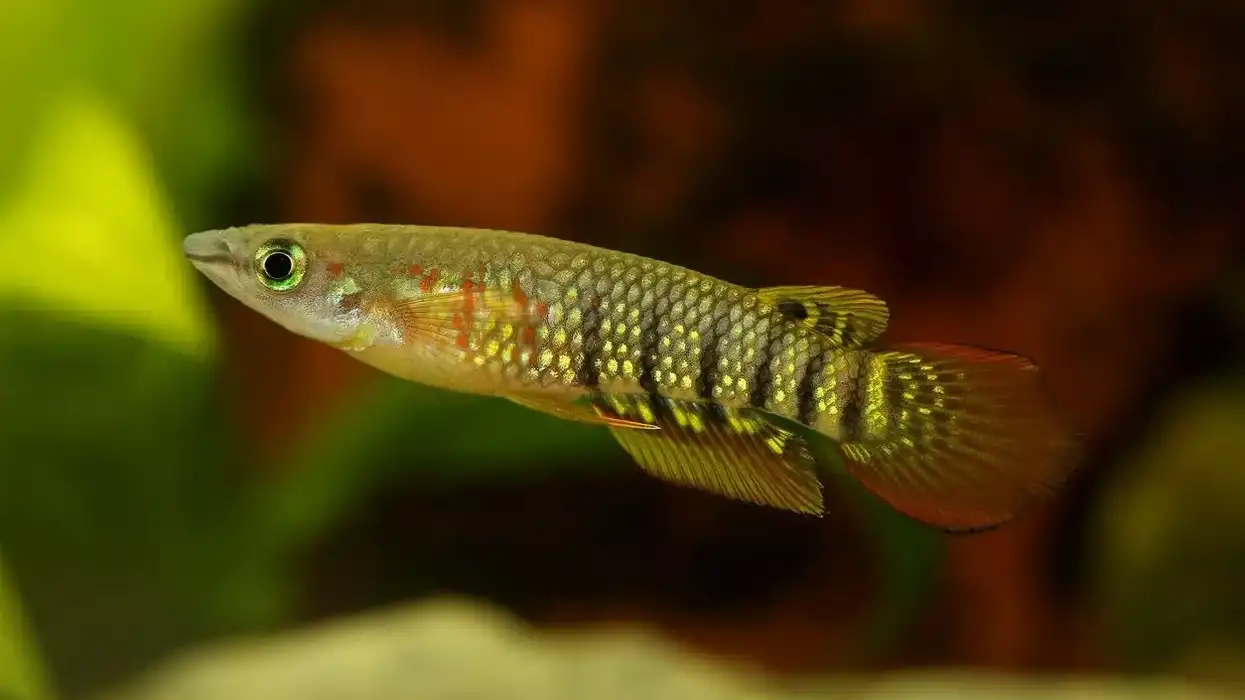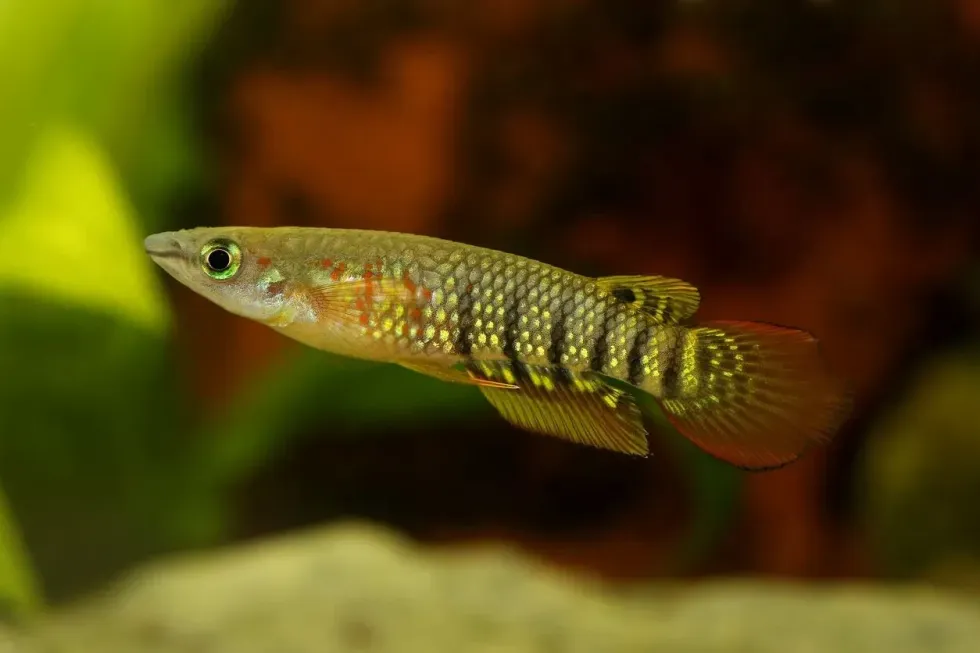Want to spice up your aquarium with an iridescent golden fish? Look no further than the golden panchax (Aplocheilus lineatus).
Also known as the golden wonder killifish, striped panchax, and Malabar killifish, it is a beautiful tank fish found in South Asia. This highly adaptable and hardy fish is originally gray-green in color, but it has been specially cultivated to bear a luminous gold color.
It is a surface-dwelling fish that can be found inhabiting the upper portion of a tank.
Even though this fish can adjust to any environment, it does need a tank that can feel like home. A tank that has floating plants where they can hide, a temperature between 72-77 F (22.2-25 C), and a slightly acidic water condition is most suitable for them.
Although ideal for a community tank, this species of killifish is a carnivore and a natural predator that is known to feed on many common tank fishes. Keep reading to learn more about the golden panchax.
If you want to keep learning, do check out some interesting facts and information about the Pacific salmon facts and tilefish facts to learn more.
Golden Panchax Interesting Facts
What type of animal is a golden panchax?
The golden panchax is a species of fish.
What class of animal does a golden panchax belong to?
This fish is of the Actinopterygii class of animals. Its scientific name is Aplocheilus lineatus. The golden-yellow colored fish belongs to the family Aplocheilidae and genus Aplocheilus.
How many golden panchax are there in the world?
An accurate estimate of the number of mature golden panchax is unrecorded. Since it has a wide range in South Asian oceans and is a popular fish in the aquarium trade all over the world, we can assume that the population of this species is stable.
Where does a golden panchax live?
The ancestors of the striped panchax killifish can be traced back to Africa, but their native land is Peninsular India and Sri Lanka. Although the fish is concentrated in South Asia, it is definitely not restricted to it.
The golden panchax can adapt to aquariums anywhere. They can be found as pet fishes in places like Mynamar, Singapore, and the US.
What is a golden panchax's habitat?
The golden panchax fish inhabits rivers, reservoirs, paddy fields, swamps, streams, and small waterways. Although it is a freshwater fish, it can also be found in brackish ponds.
Who does a golden panchax live with?
The fish prefers to live in solitude because it can be quarrelsome even with its own species. When in the wild, they lead solitary lives. If they are being bred in a tank or aquarium, it is best to either keep them alone or in groups of four.
How long does a golden panchax live?
The golden panchax fish can survive up to four years provided they are given proper care and an adequate environment to thrive in.
How do they reproduce?
Golden panchax breeding takes place perennially, and a healthy spawning pair may deposit around 100-250 eggs daily and for several weeks. The female fish lays her eggs on moss or under small plants where they can be easily hidden.
If you're breeding fish in a tank, it would be suitable to give them a clean spawning mop. Once the females have laden the mop with eggs, you can separate them in another tank that has the same parameters as the previous tank.
This will help ensure that the eggs are safe. It takes 12-15 days for them to hatch and reveal the fry.
What is their conservation status?
The conservation status of the striped panchax is evaluated as Least Concern by the International Union for Conservation of Nature.
Golden Panchax Fun Facts
What does a golden panchax look like?
The golden panchax is a small fish of 3.9 in (10 cm). It has a slender and elongated body with a slightly arched back.
The head of the fish appears to be flattened and snout pointy. The tiny fish has a surprisingly wide mouth which helps it to catch its prey. The body of the fish is a shimmery or luminous golden-yellow.
The males of this species are larger, sport a more prominent coloration, and their anal fin is more pointed. The females also have numerous perpendicular bars that stretch to their caudal fin.
How cute are they?
The fish is adorable thanks to its beautiful gold color and small size. It's no surprise that they're so popular in the aquarium trade.
How do they communicate?
The fish is peaceful and prefers to lead a solitary life. They usually don't feel the need to communicate at all. They can, however, become quarrelsome and aggressive when feeling threatened.
How big is a golden panchax?
The golden panchax is a rather small fish. They have a length of 3.9 in (10 cm) on average and are smaller than a clown wrasse which is 14-16 in (35.6-40.6 cm) in length.
How fast can a golden panchax swim?
This species of killifish are not good swimmers. They are what you would call surface or top-dwelling fish. Since they are not strong swimmers, you will rarely find them at the bottom of a tank or aquarium.
How much does a golden panchax weigh?
An accurate estimate of the weight of the striped panchax is unavailable. However, its miniature size suggests that the fish is rather lightweight.
What are the male and female names of the species?
No specific name has been assigned to the males and females of the species. They are simply referred to as male golden panchax and female golden panchax.
What would you call a baby golden panchax?
A young or baby striped panchax is called a fry.
What do they eat?
The fish is a natural predator when in the wild. They prey on any animal that fits into their mouth.
Their choice of food is fleas, river worms, mosquitoes, insects and their larvae, and smaller fishes.
It is advised not to keep small fishes like neon tetras and danios as their tankmates as there is a good chance the killifish will end up feeding on them. When kept in an aquarium, they feed on a variety of frozen foods and live foods like brine shrimp, tubifex, bloodworms, mosquitoes, crickets, and white worms.
Are they dangerous?
This fish is harmless to humans, but it is not uncommon for this carnivorous fish to treat smaller aquarium fishes like neon tetras and danios as food. In fact, this fish can even be seen fighting and quarreling among its own species.
Would they make a good pet?
The golden or striped panchax is a common aquarium fish, especially in southern Asia. This fish is extremely hardy, undemanding, and can adapt to most water conditions.
The fish is even immune to most illnesses that are borne in an aquarium. Although it is quite hassle-free to keep the panchax as a pet, there are some criteria that must be met if you want to ensure their longevity.
Since the fish typically dwells on the surface, the tank size should be longer rather than taller. The tank should also contain aquatic vegetation like floating plants and moss to replicate their natural habitat.
Did you know...
The minimum tank size required to raise a golden panchax is 20 gal (75.7 l). It has to be increased depending on how many species of fish you want to include in your tank. It should also have a strong lid, as the killifish is known to stay on the surface and has a tendency to jump.
Each fry is born with a yolk sac on its belly which disappears or is rather absorbed by the fish as it matures.
Cannibalism is quite common among the fry. Only the fittest can survive.
Why is it called golden panchax?
This species of killifish gets its name from its gold or golden color form.
Is the golden panchax a community fish?
Yes, the golden panchax is a good community fish. It is peaceful and adapts easily to almost every home tank.
However, caution must be exercised while selecting golden panchax tank mates. The fish is rather predatory in nature and will not think twice before feeding on aquarium fishes that are smaller in size. It is best to keep them separated from guppies, neon tetras, rasbora, and danios.
Here at Kidadl, we have carefully created lots of interesting family-friendly animal facts for everyone to discover! Learn more about some other fish including emperor angelfish fun facts or black grouper interesting facts for kids.
You can even occupy yourself at home by coloring in one of our free printable intricate fish coloring pages.
Second image by Marrabbio2









